Business Process-Organizational Structure (BP-OS) Performance Measurement Model and Problem-Solving Guidelines for Efficient Organizational Management in an Ontact Work Environment
Abstract
:1. Introduction
2. Related Works
2.1. Factors Affecting Organizational Performance in the Ontact Work Environment and the Need to Consider Them
2.2. Evaluation and Redesign Method of Business Process, Organizational Structure, and Human Resource Allocation
2.3. The need for Organizational Performance Prediction through Enterprise Simulation and the Limitations of Existing Enterprise Simulations
3. Performance Measurement Model in the Ontact Work Environment
3.1. BP-OS Performance Measurement Model in General Work Environment through Total Task Cycle Time
3.2. BP-OS Performance Measurement Model in the Ontact Work Environment
- Delay in pure execution tine (α)
- 2.
- Delay in approval/assignment time (𝛽)
- 3.
- Delay in negligence time (γ)
- 4.
- Factors increasing total task cycle time (δ)
- 5.
- Factors decreasing total task cycle time (θ)
- 6.
- Factors independently affecting total task cycle time in the ontact work environment (ε)
4. BP-OS Simulation Modeling in the Ontact Work Environment
4.1. Enterprise Simulation Architecture in the Ontact Work Environment
4.1.1. Defining Data Used in Enterprise Simulations
Business Process Definition
Organizational Structure Definition
Performer Definition
- -
- Left: Fast, execution time due to excellent concentration, good working environment, etc.
- -
- Mode: Most common execution time. The value of the execution time that can be expected from the performer in the absence of exceptional circumstances.
- -
- Right: Slow execution time due to poor concentration, poor working environment, etc.
Manager Definition: Availability
- -
- Left: Fast approval/assignment time with excellent concentration and smooth communication with performers.
- -
- Mode: Common approval/assignment time expected from managers with no special situations.
- -
- Right: Slow approval/assignment time with reduced concentration and difficult communication with performers.
4.1.2. Prerequisites for Enterprise Simulation
4.2. Enterprise Simulation in the Ontact Work Environment: Case Study
4.3. Enterprise Simulation Results in the Ontact Work Environment
4.4. Analysis of Enterprise Simulation Results in the Ontact Work Environment
5. Problem-solving Guidelines in the Ontact Work Environment
5.1. Streamlining of Organizational Structure and Reporting System
5.2. Streamlining Business Process
5.3. Efficient Human Resource Allocation for Non-Face-to-Face Business Operation
6. Conclusions
Author Contributions
Funding
Institutional Review Board Statement
Informed Consent Statement
Data Availability Statement
Conflicts of Interest
References
- Park, H.W. ‘Corona Holiday’... Courier 30%, Industrial Accidents 312% Yonhapnewstv. Available online: https://www.yonhapnewstv.co.kr/news/MYH20210921001000038?did=1825m (accessed on 21 September 2021).
- Lee, B.; Lee, C.; Choi, I.; Kim, J. Analyzing Determinants of Job Satisfaction Based on Two-Factor Theory. Sustainability 2022, 14, 12557. [Google Scholar] [CrossRef]
- Lee, S.H.; Do, H.O.; Seo, K.D. A study on management plans for activating of smart work. J. Digit. Converg. 2011, 9, 245–252. [Google Scholar]
- Kwon, M.; Jeon, S.H. Why permit telework? Exploring the determinants of California city gevernments’ decisions to permit telework. Public Pers. Manag. 2017, 46, 239–262. [Google Scholar] [CrossRef]
- Bucea-Manea-Tonis, R.; Prokop, V.; Ilic, D.; Gurgu, E.; Bucea-Manea-Tonis, R.; Braicu, C.; Moanta, A. The relationship between Eco-innovation and smart working as support for sustainable management. Sustainability 2021, 13, 1437. [Google Scholar] [CrossRef]
- Choi, H.; Lee, J.Y.; Choi, Y.; Juan, Y.; Lee, C.K. How to Enhance Smart Work Effectiveness as a Sustainable HRM Practice in the Tourism Industry. Sustainability 2022, 14, 2218. [Google Scholar] [CrossRef]
- Han, S.; Shin, J.; Lee, S.; Park, J. Activation of Ontact Research Using Science & Technology Knowledge Infrastructure ScienceON. J. Inf. Sci. Theory Pract. 2022, 10, 1–11. [Google Scholar]
- Šikýr, M. Determinants of employee performance: How to achieve sustained competitive advantage. In Proceedings of the 5th International Days of Statistics and Economics, Prague, Czech Republic, 22–23 September 2011; pp. 606–614. Available online: http://msed.vse.cz/files/2011/Sikyr.pdf (accessed on 17 June 2021).
- Sostero, M.; Milasi, S.; Hurley, J.; Fernandez- Macías, E.; Bisello, M. Teleworkability and the COVID-19 crisis: A new digital divide? In JRC Working Papers Series on Labor, Education and Technology; European Comission: Brussels, Belgium, 2020. [Google Scholar]
- Palm, K.; Bergman, A.; Rosengren, C. Toward more proactive sustainable human resource management practices? A study on stress due to the ICT-Mediated integration of work and private life. Sustainability 2020, 12, 8303. [Google Scholar] [CrossRef]
- Chams, N.; García-Blandón, J. On the importance of sustainable human resource management for the adoption of sustainable development goals. Int. J. Prod. Econ. 2019, 140, 219–226. [Google Scholar] [CrossRef]
- Wikhamn, W. Innovation, sustainable HRM and customer satisfaction. Int. J. Hosp. Manag. 2019, 76, 102–110. [Google Scholar] [CrossRef]
- Ullah, Z.; Álvarez-Otero, S.; Sulaiman, M.; Sial, M.; Ahmad, N.; Scholz, M.; Omhand, K. Achieving Organizational Social Sustainability through Electronic Performance Appraisal Systems: The Moderating Influence of Transformational Leadership. Sustainability 2021, 13, 5611. [Google Scholar] [CrossRef]
- Chen, C.K.; Tsai, C.H. ‘Developing a process re-engineering-oriented organizational change exploratory simulation system (PROCESS). Int. J. Prod. Res. 2008, 46, 4463–4482. [Google Scholar] [CrossRef]
- Shin, C.; Park, J. ‘Classifying social enterprises with organizational culture, network and socioeconomic performance: Latent profile analysis approach. J. Open Innov. Technol. Mark. Complex. 2019, 5, 17. [Google Scholar] [CrossRef]
- Vera-Baquero, A.; Colomo-Palacios, R.; Molloy, O. Business process analytics using a big data approach. IT Prof. 2013, 15, 29–35. [Google Scholar] [CrossRef]
- Liu, W.; Wang, P.; Du, Y.; Zhou, M.; Yan, C. Extended logical Petri nets- based modeling and analysis of business processes. IEEE Access 2017, 5, 16829–16839. [Google Scholar] [CrossRef]
- Park, G.; Chung, L.; Khan, L. A modeling framework for business process reengineering using big data analytics and a goal-orientation. In Proceedings of the 11th International Conference on Research Challenges in Information Science (RCIS), Brighton, UK, 10–12 May 2017; pp. 21–32. [Google Scholar]
- Polyvyanyy, A.; Ouyang, C.; Barros, A.; van der Aalst, W.M. Process querying: Enabling business intelligence through query-based process analytics. Decis. Support Syst. 2017, 100, 41–56. [Google Scholar] [CrossRef]
- Davenport, T.H. Process Innovation: Reengineering Work through Information Technology; Harvard Business Press: Cambridge, MA, USA, 1993. [Google Scholar]
- van der Aalst, W.M.P.; Hofstede, A.H.M.T.; Weske, M. Business process management: A survey. In Proceedings of the 1st International Conference on Business Process Management, Eindhoven, The Netherlands, 26–27 June 2003; Volume 2678, pp. 1–12. [Google Scholar]
- van der Aalst, W.M.P.; van Dongen, B.F.; Herbst, J.; Maruster, L.; Schimm, G.; Weijters, A.J.M.M. Workflow mining: A survey of issues and approaches. Data Knowl. Eng. 2003, 47, 237–267. [Google Scholar] [CrossRef]
- Hearn, S.N.; Choi, I. Creating a process and organization fit index: An approach toward optimal process and organization design. Knowl. Proc. Manag. 2013, 20, 21–29. [Google Scholar] [CrossRef]
- van der Aalst, W. Process Mining: Discovery, Conformance and Enhancement of Business Processes; Springer: Berlin/Heidelberg, Germany, 2011; Volume 2. [Google Scholar]
- Weijters, A.J.M.; van der Aalst, W.M.P.; van Dongen, B.F.; Günther, C.W.; Mans, R.S.; de Medeiros, A.A.; Verbeek, H.M.W. Process mining with ProM. In Proceedings of the 19th Belgium-Netherlands Conference on Artificial Intelligence (BNAIC 2007), Utrecht, The Netherlands, 5–6 November 2007; pp. 420–425. [Google Scholar]
- Gardner, R. The Process-Focused Organization: A Transition Strategy for Success; Quality: Milwaukee, WI, USA, 2004. [Google Scholar]
- Pérez, M.P.; Sánchez, A.M.; de Carnicer, M.P.L. Benefits and barriers of telework: Perception differences of human resources managers according to company’s operations strategy. Technovation 2002, 22, 775–783. [Google Scholar] [CrossRef]
- Silva-C, A. The attitude of managers toward telework, why is it so difficult to adopt it in organizations? Technol. Soc. 2019, 59, 101133. [Google Scholar] [CrossRef]
- Boell, S.K.; Cecez-Kecmanovic, D.; Campbell, J. Telework paradoxes and practices: The importance of the nature of work. New Technol. Work Employ. 2016, 31, 114–131. [Google Scholar] [CrossRef]
- Caillier, J.G. Does satisfaction with family-friendly programs reduce turnover? A panel study conducted in U.S. federal agencies. Public Pers. Manag. 2016, 45, 284–307. [Google Scholar] [CrossRef]
- Zhang, S.; Moeckel, R.; Moreno, A.T.; Shuai, B.; Gao, J. A work-life conflict perspective on telework. Transp. Res. A Policy Pract. 2020, 141, 51–68. [Google Scholar] [CrossRef] [PubMed]
- Kelliher, C.; Anderson, D. Doing more with less? Flexible working practices and the intensification of work. Hum. Relat. 2010, 63, 83–106. [Google Scholar] [CrossRef]
- Greasley, A. Using process mapping and business process simulation to support a process-based approach to change in a public sector organisa- tion. Technovation 2006, 26, 95–103. [Google Scholar] [CrossRef]
- Zülch, G.; Grobel, T. Shaping the organization of order processing with the simulation tool FEMOS. Int. J. Prod. Econ. 1996, 46–47, 251–260. [Google Scholar] [CrossRef]
- Rozinat, A.; Mans, R.S.; Song, M.; van der Aalst, W.M.P. Discovering simulation models. Inf. Syst. 2009, 34, 305–327. [Google Scholar] [CrossRef] [Green Version]
- Berk, L.; Bertsimas, D.; Weinstein, A.M.; Yan, J. Prescriptive analytics for human resource planning in the professional services industry. Eur. J. Oper. Res. 2019, 272, 636–641. [Google Scholar] [CrossRef]
- Filho, C.F.F.C.; Rocha, D.A.R.; Costa, M.G.F.; de Pereira, W.C.A. Using constraint satisfaction problem approach to solve human resource allocation problems in cooperative health services. Expert Syst. Appl. 2012, 39, 385–394. [Google Scholar] [CrossRef]
- Suggs, R.; Lewis, B. Enterprise simulation-a practical application in business planning. In Proceedings of the 2007 Winter Simulation Conference, Washington, DC, USA, 9–12 December 2007; pp. 205–209. [Google Scholar]
- Mielke, R.R. Applications for enterprise simulation. In Proceedings of the WSC’99. 1999 Winter Simulation Conference Proceedings. ‘Simulation-A Bridge to the Future’ (Cat. No. 99CH37038), Phoenix, AZ, USA, 5–8 December 1999; Volume 2, pp. 1490–1495. [Google Scholar]
- Barjis, J.; Verbraeck, A. The relevance of modeling and simulation in enterprise and organizational study. In Workshop on Enterprise and Organizational Modeling and Simulation; Springer: Berlin/Heidelberg, Germany, 2010; pp. 15–26. [Google Scholar]
- Grover, V.; Jeong, S.R.; Kettinger, W.J.; Teng, J.T. The implementation of business process reengineering. J. Manag. Inf. Syst. 1995, 12, 109–144. [Google Scholar] [CrossRef]
- Lee, S.; Choi, I.; Kim, H.; Lim, J.; Sung, S. Comprehensive Simulation and Redesign System for Business Process and Organizational Structure. IEEE Access 2020, 8, 106322–106333. [Google Scholar] [CrossRef]
- Russell, N.; van der Aalst, W.M.; Hofstede, A.H.T.; Edmond, D. Workflow resource patterns: Identification, representation and tool sup- port. In Advanced Information Systems Engineering; Spinger: Berlin, Germany, 2005; pp. 216–232. [Google Scholar]
- Lee, J.; Sung, S.; Song, M.; Choi, I. A business process simulation framework incorporating the effects of organizational structure. Int. J. Ind. Eng. 2015, 22, 454–466. [Google Scholar]
- Januszczak, J.; Hook, G. Simulation standard for business process management. In Proceedings of the 2011 Winter Simulation Conference (WSC), Phoenix, AZ, USA, 11–14 December 2011; pp. 741–751. [Google Scholar]
- Gregoriades, A.; Sutcliffe, A. A socio-technical approach to business process simulation. Decis. Support Syst. 2008, 45, 1017–1030. [Google Scholar] [CrossRef]
- Giaglis, G.M.; Paul, R.J.; Hlupic, V. Integrating simulation in organizational design studies. Int. J. Inf. Manag. 1999, 19, 219–236. [Google Scholar] [CrossRef]
- Sakr, S.; Maamar, Z.; Awad, A.; Benatallah, B.; van der Aalst, W.M.P. Business process analytics and big data systems: A roadmap to bridge the gap. IEEE Access 2018, 6, 77308–77320. [Google Scholar] [CrossRef]
- Gao, X. Towards the next generation intelligent BPM–in the era of big data. In Business Process Management (Lecture Notes in Computer Science); Springer: Berlin, Germany, 2013; pp. 4–9. [Google Scholar]
- van der Aalst, W.; Damiani, E. Processes meet big data: Connecting data science with process science. IEEE Trans. Serv. Comput. 2015, 8, 810–819. [Google Scholar] [CrossRef]
- Wamba, S.F.; Mishra, D. Big data integration with business processes: A literature review. Bus. Process Manag. J. 2017, 23, 477–492. [Google Scholar] [CrossRef] [Green Version]
- Smith, H.; Fingar, P. Business Process Management: The Third Wave; Meghan-Kiffer: Tampa, FL, USA, 2003; Volume 1. [Google Scholar]
- Daft, R.L. Organization Theory and Design; South-Western: Cincinnati, OH, USA, 2004. [Google Scholar]
- Hammer, M.; Stanton, S. How process enterprises really work. Harvard Bus. Rev. 1999, 77, 108–120. [Google Scholar]
- Becker, J.; Kugeler, M.; Rosemann, M.; Eds. (Eds.) Process Management: A Guide for the Design of Business Processes; Springer: Berlin, Germany, 2013. [Google Scholar]
- Zhao, W.; Zhao, X. Process mining from the organizational perspective. In Advances in Intelligent Systems and Computing; Springer: Berlin, Germany, 2014; pp. 701–708. [Google Scholar]
- Song, M.; van der Aalst, W.M.P. Towards comprehensive support for organizational mining. Decis. Support Syst. 2008, 46, 300–317. [Google Scholar] [CrossRef] [Green Version]
- van der Aalst, W.M.P.; Reijers, H.A.; Song, M. Discovering social networks from event logs. Comput. Supported Coop. Work 2005, 14, 549–593. [Google Scholar] [CrossRef] [Green Version]
- Sellami, R.; Gaaloul, W.; Moalla, S. An ontology for workflow organizational model mining. In Proceedings of the IEEE 21st International Workshop on Enabling Technologies: Infrastructure for Collaborative Enterprises, Toulouse, France, 25–27 June 2012; pp. 199–204. [Google Scholar]
- Kim, J.H.; Jung, S. Study on CEO characteristics for management of public art performance centers. J. Open Innov. 2015, 1, 5. [Google Scholar] [CrossRef] [Green Version]
- Nam, K.; Kim, B.; Carnie, B. Service open innovation; design elements for the food and beverage service business. J. Open Innov. Technol. Mark. Complex. 2018, 4, 53. [Google Scholar] [CrossRef] [Green Version]
- Bento, F.; Garotti, L. Resilience beyond formal structures: A network perspective towards the challenges of an aging workforce in the oil and gas industry. J. Open Innov. Technol. Mark. Complex. 2019, 5, 15. [Google Scholar] [CrossRef] [Green Version]
- Rakthai, T.; Aujirapongpan, S.; Suanpong, K. Innovative capacity and the performance of businesses incubated in university incubator units: Empirical study from universities in Thailand. J. Open Innov. Technol. Mark. Complex. 2019, 5, 33. [Google Scholar] [CrossRef]

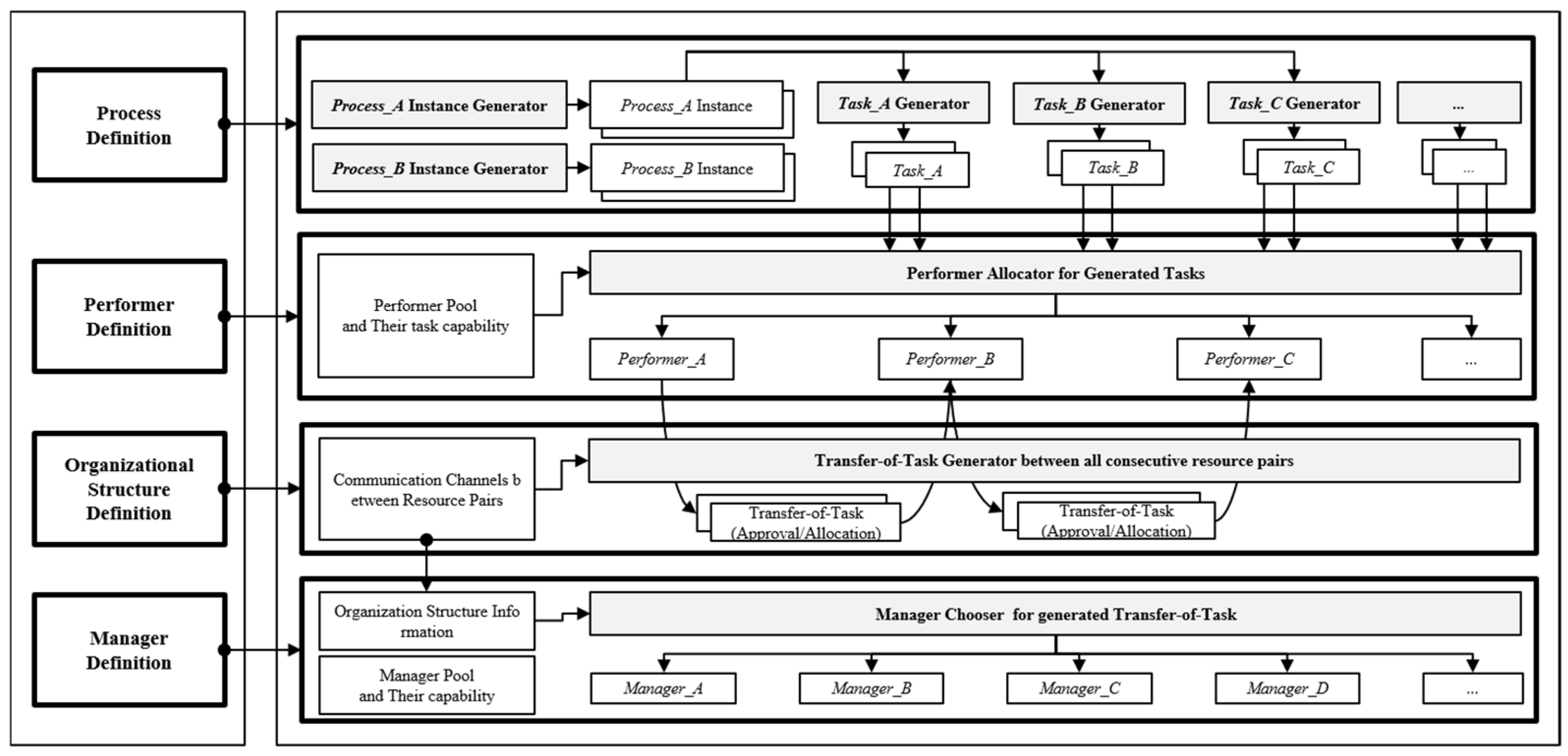



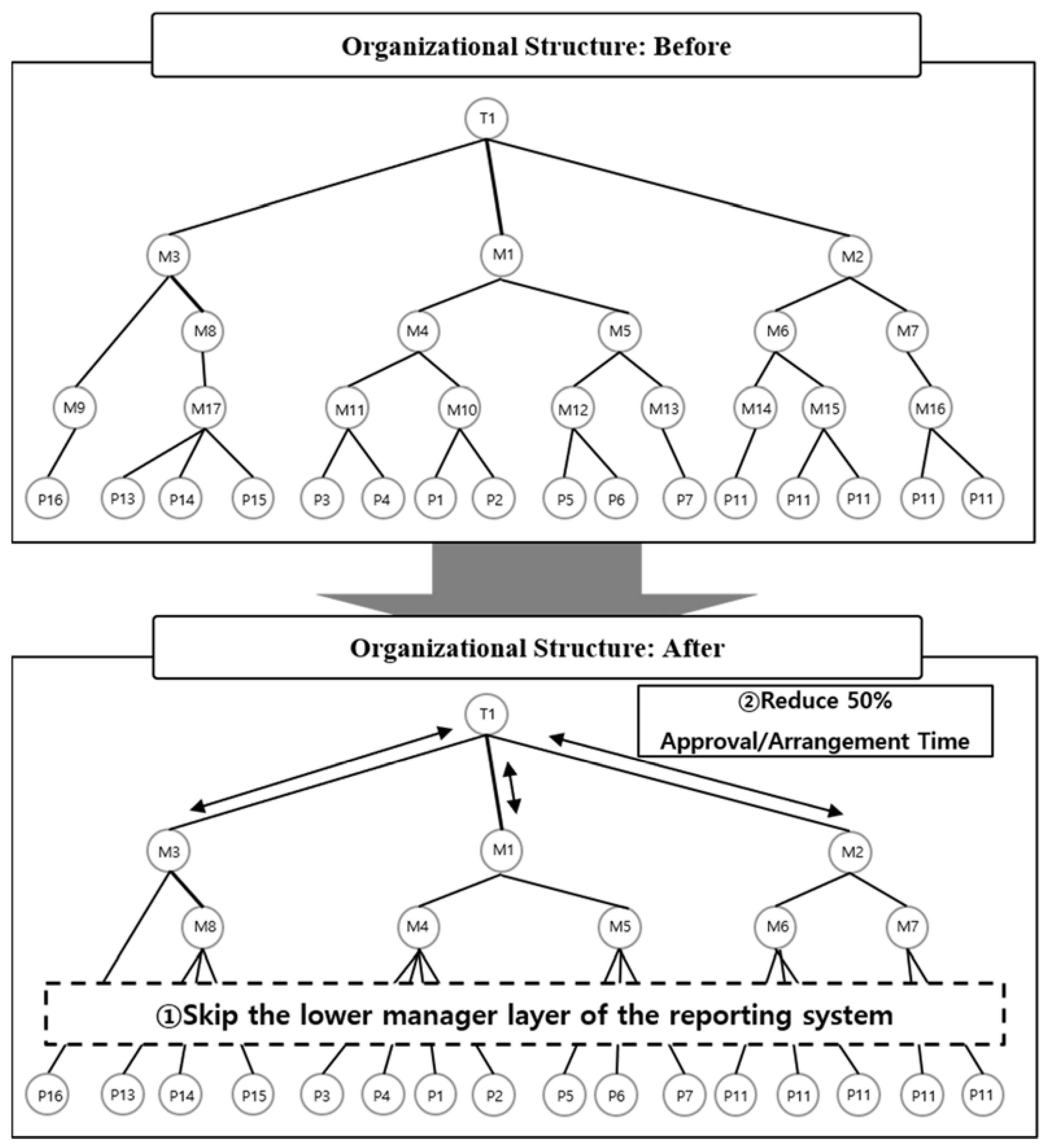

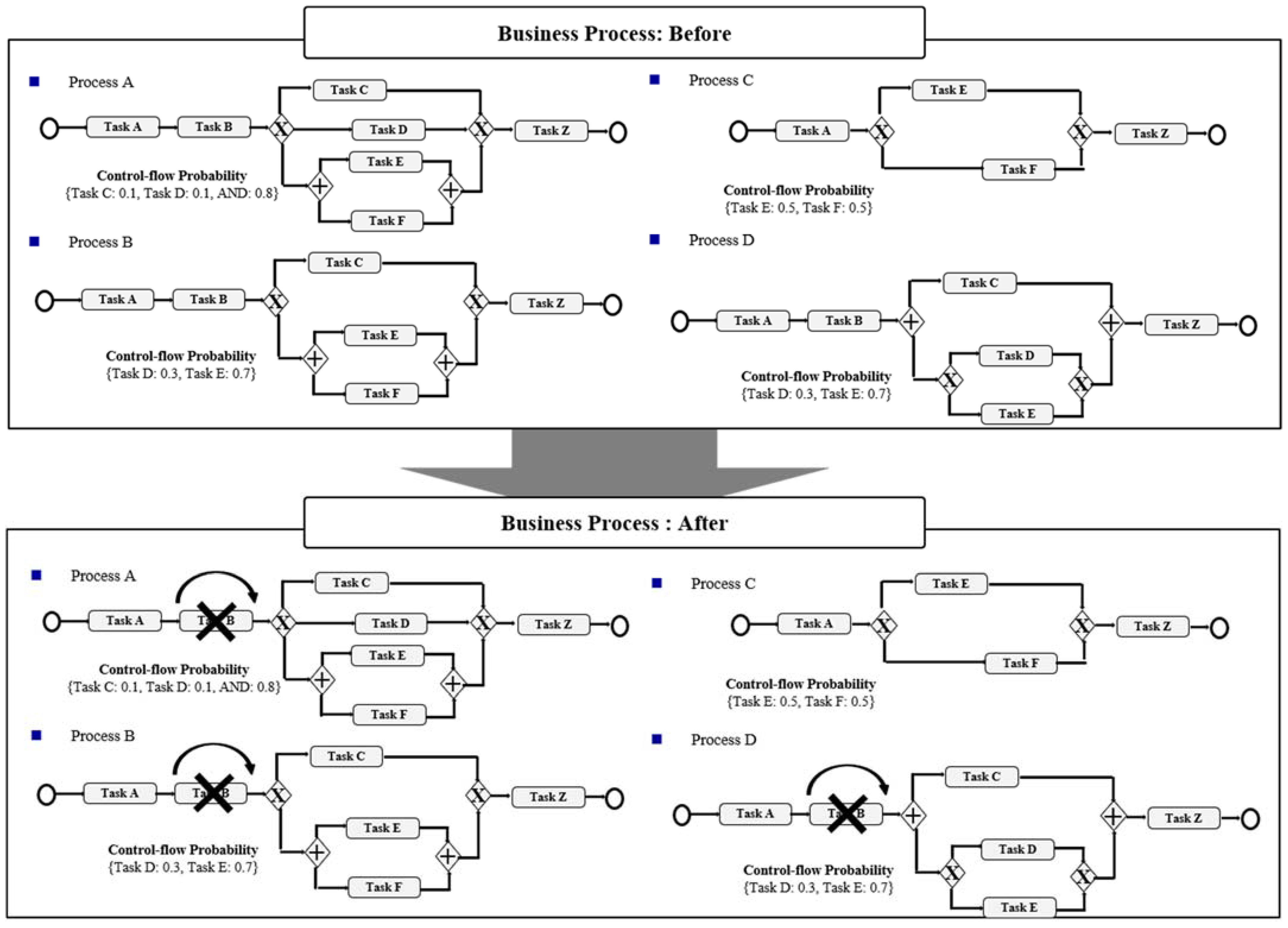
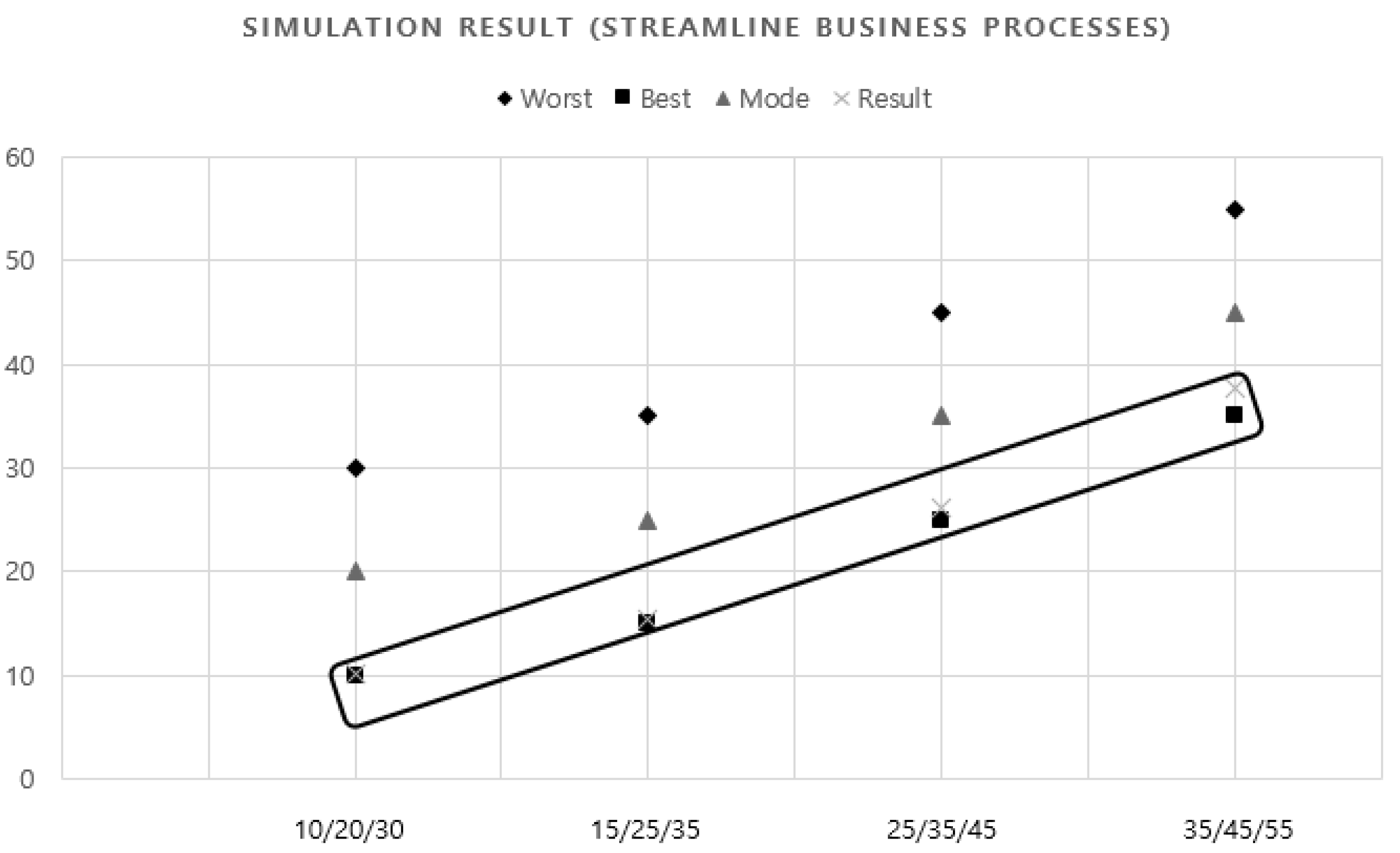
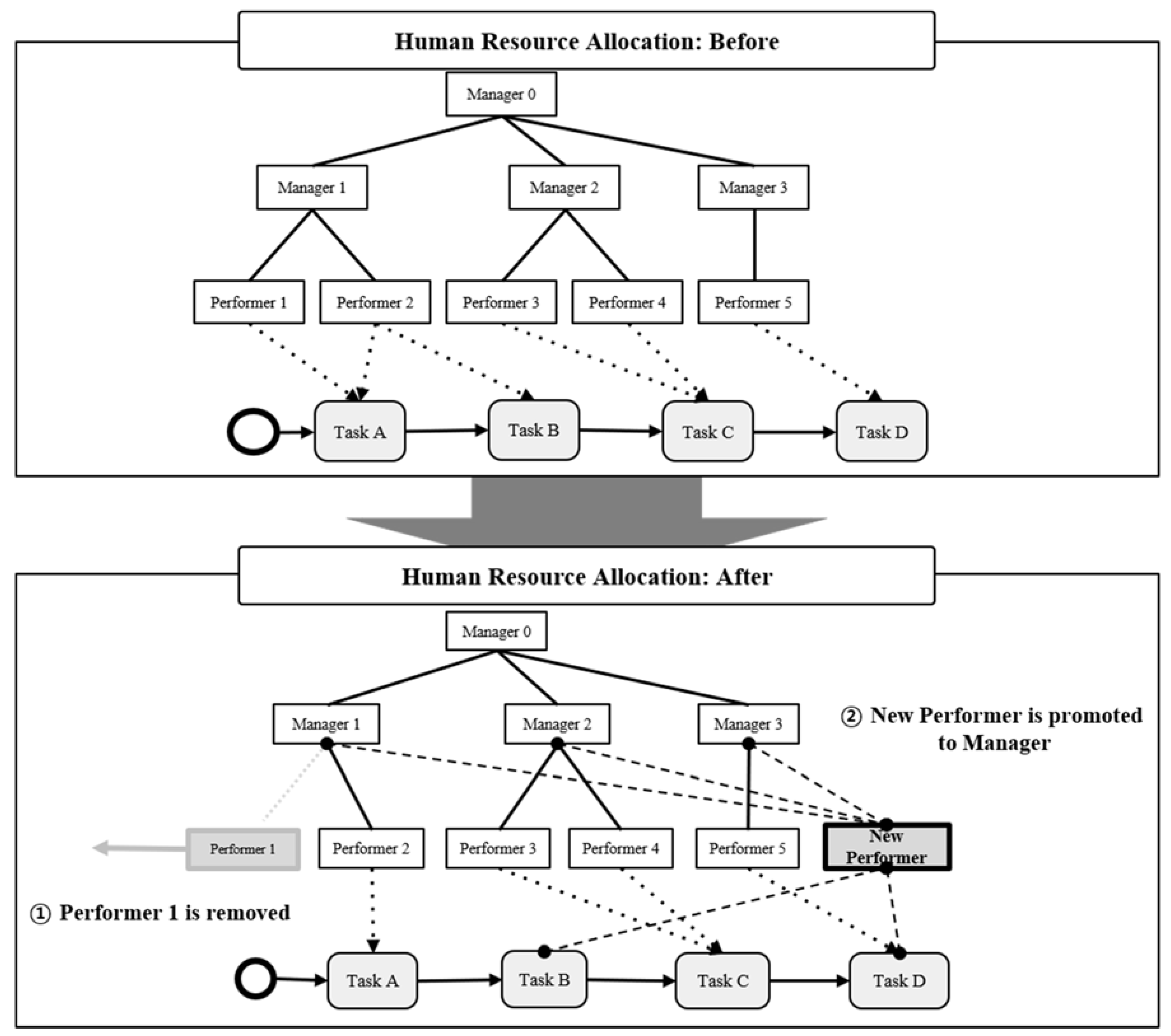

| Execution Time (A + α) | Approval/Assignment Time (B + 𝛽) | Negligence Time (C + γ) | |
|---|---|---|---|
| No Delay | 2/4/8 | 1/2/4 | Fixed value accordingto Case |
| 15%/25%/35% delay rate applied | 2.3/4.6/9.2 2.5/5/10 2.7/5.4/10.8 | 1.15/2.3/4.6 1.25/2.5/5 1.35/2.7/5.4 | Fixed value according to Case |
| 25%/35%/45% delay rate applied | 2.5/5/10 2.7/5.4/10.8 2.9/5.8/11.6 | 1.25/2.5/5 1.35/2.7/5.4 1.45/2.9/5.8 | Fixed value according to Case |
| 35%/45%/55% delay rate applied | 2.7/5.4/10.8 2.9/5.8/11.6 3.1/6.2/12.4 | 1.35/2.7/5.4 1.45/2.9/5.8 1.55/3.1/6.2 | Fixed value according to Case |
| Case I | Case II | Case III | |
|---|---|---|---|
| No Delay | 145,884 | 164,077 | 173,672 |
| 15%/25%/35% Delay rate applied | 178,433 (27.9% delay) | 218,148 (32.9% delay) | 217,264 (25.1% delay) |
| 25%/35%/45% Delay rate applied | 196,077 (38.4% delay) | 236,119 (43.9% delay) | 241,056 (38.8% delay) |
| 35%/45%/55% Delay rate applied | 210,392 (50.0% delay) | 254,522 (55.0% delay) | 265,544 (52.9% delay) |
Publisher’s Note: MDPI stays neutral with regard to jurisdictional claims in published maps and institutional affiliations. |
© 2022 by the authors. Licensee MDPI, Basel, Switzerland. This article is an open access article distributed under the terms and conditions of the Creative Commons Attribution (CC BY) license (https://creativecommons.org/licenses/by/4.0/).
Share and Cite
Kim, H.; Choi, I.; Lim, J.; Sung, S. Business Process-Organizational Structure (BP-OS) Performance Measurement Model and Problem-Solving Guidelines for Efficient Organizational Management in an Ontact Work Environment. Sustainability 2022, 14, 14574. https://doi.org/10.3390/su142114574
Kim H, Choi I, Lim J, Sung S. Business Process-Organizational Structure (BP-OS) Performance Measurement Model and Problem-Solving Guidelines for Efficient Organizational Management in an Ontact Work Environment. Sustainability. 2022; 14(21):14574. https://doi.org/10.3390/su142114574
Chicago/Turabian StyleKim, Hokyeom, Injun Choi, Jitaek Lim, and Sanghyun Sung. 2022. "Business Process-Organizational Structure (BP-OS) Performance Measurement Model and Problem-Solving Guidelines for Efficient Organizational Management in an Ontact Work Environment" Sustainability 14, no. 21: 14574. https://doi.org/10.3390/su142114574




